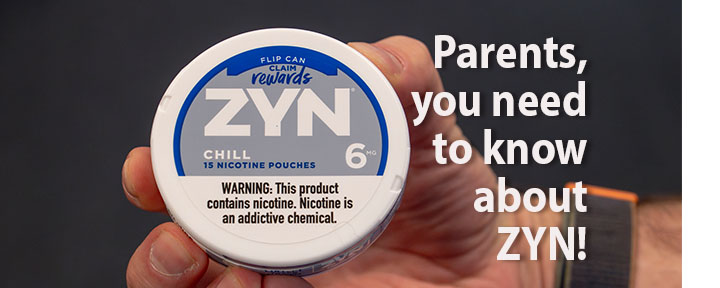
What is Zyn?
Do you know what Zyn is? Have you heard of the “upper-decky lip pillow? If you have tween or teen children or grandchildren, hang on because you need to be in the know. Zyn is the smokeless alternative to vapes, and vapes was the less-noticeable form of smoking cigarettes. Zyn is a nicotine pouch that is placed under your lip like chewing tobacco or tobacco dip. It is less visible than vapes because there are no cartridges or battery pens, and certainly inconspicuous next to cigarettes and smoke.
Zyn comes in 2 strengths: 3- and 6-milligram pouches. The nicotine ingredient is very addictive – especially for young tweens. First-time users often vomit or pass out when experimenting with the 6 milligram pouches. Zyn is packaged in tins that contain 16 little white rectangles – AKA lip cushions. Dentists have reported gum injuries and concerns about the toxic chemicals in the pouches that can cause periodontal and gum disease in patients who use Zyn. They are known to increase heart rate and blood pressure. The nicotine can also negatively affects kids’ mental health. At first, they may feel a sense of relaxation that is short lived and followed up with a spike in edginess and anxiety that ultimately causes a vicious cycle of needing relaxation to offset their anxiety. And because Zyn is highly addictive, it adds another layer of mental agitation. Still this is such a new craze that there hasn’t been enough time to understand all of the risks associated with these little nicotine pouches.
Phillip Morris International purchased Swedish Match (the Zyn-brand manufacturer) in early 2023 (barely a year ago) and they expect to make $2 billion by end of 2024. Rogue, Lix, and Velo are also popular Zyn alternatives. The many companies that produce nicotine pouches are hoping to hook young kids on their brands so they’ll have customers for life. Instead of big billboards, magazine ads, or TV commercials, these manufacturers advertise on social media targeting specific age groups. They also use influencers who are like the popular kids that most kids want to follow. Known as Zynfluencers, they send powerful messages using TikTok videos to young kids about how cool it is to Zyn and how much fun it is to have that little blast of energy.
Unlike smoking cigarettes where parents can smell the smoke or vaping where parents find vape pens and other paraphernalia, Zyn is almost undetectable. Students Zyn in class and at home. Most teachers and parents don’t know about Zyn so students are gravitating to it. Since 2014, Zyn has been increasing in popularity and many consider it the new vape.
Even the most concerned parents face daunting odds of positively influencing their children about Zyn. Advertisers and Zynfluencers are on youth social media feeds brainwashing them for hours each day. Parents don’t see the same ads or TikTok videos because marketing companies create algorhythms to target this young demographic.
It’s not like it was when I was a kid. Back then, parents saw the same ads and commercials that the kids saw, and they could restrict what their children read and TV shows they watched. We read real books and magazines (paper), and we all watched the same shows and movies on our one TV set in the house. Most kids today are on their smartphones or tablets for hours without parental oversight.
Parents, you need to understand Zyn. Frame the truth about how Zyn negatively affects your children’s health before they get pulled into Zyn with friends. Be proactive and open the discussion. By framing the idea that Zyn nicotine pouches are a marketing ploy to make young kids addicted for life, you may have a chance to ward off the inevitable dilemma in the first place.
Parents, you have the right to check your children’s smartphones, tablets and backpacks. Limit screen time to one hour per night so they choose how they want to spend that precious hour. Talk to them about ads, influencers, and other bombardment of information. Parents, you have an important role to play as your child’s chief advocate. Open the discussion and be involved in every aspect of your child’s life because you are fighting an invisible enemy in a cyber-battleground that can infiltrate your child’s mind and behavior.

What is Zyn?
Do you know what Zyn is? Have you heard of the “upper-decky lip pillow? If you have tween or teen children or grandchildren, hang on because you need to be in the know. Zyn is the smokeless alternative to vapes, and vapes was the less-noticeable form of smoking cigarettes. Zyn is a nicotine pouch that is placed under your lip like chewing tobacco or tobacco dip. It is less visible than vapes because there are no cartridges or battery pens, and certainly inconspicuous next to cigarettes and smoke.
Zyn comes in 2 strengths: 3- and 6-milligram pouches. The nicotine ingredient is very addictive – especially for young tweens. First-time users often vomit or pass out when experimenting with the 6 milligram pouches. Zyn is packaged in tins that contain 16 little white rectangles – AKA lip cushions. Dentists have reported gum injuries and concerns about the toxic chemicals in the pouches that can cause periodontal and gum disease in patients who use Zyn. They are known to increase heart rate and blood pressure. The nicotine can also negatively affects kids’ mental health. At first, they may feel a sense of relaxation that is short lived and followed up with a spike in edginess and anxiety that ultimately causes a vicious cycle of needing relaxation to offset their anxiety. And because Zyn is highly addictive, it adds another layer of mental agitation. Still this is such a new craze that there hasn’t been enough time to understand all of the risks associated with these little nicotine pouches.
Phillip Morris International purchased Swedish Match (the Zyn-brand manufacturer) in early 2023 (barely a year ago) and they expect to make $2 billion by end of 2024. Rogue, Lix, and Velo are also popular Zyn alternatives. The many companies that produce nicotine pouches are hoping to hook young kids on their brands so they’ll have customers for life. Instead of big billboards, magazine ads, or TV commercials, these manufacturers advertise on social media targeting specific age groups. They also use influencers who are like the popular kids that most kids want to follow. Known as Zynfluencers, they send powerful messages using TikTok videos to young kids about how cool it is to Zyn and how much fun it is to have that little blast of energy.
Unlike smoking cigarettes where parents can smell the smoke or vaping where parents find vape pens and other paraphernalia, Zyn is almost undetectable. Students Zyn in class and at home. Most teachers and parents don’t know about Zyn so students are gravitating to it. Since 2014, Zyn has been increasing in popularity and many consider it the new vape.
Even the most concerned parents face daunting odds of positively influencing their children about Zyn. Advertisers and Zynfluencers are on youth social media feeds brainwashing them for hours each day. Parents don’t see the same ads or TikTok videos because marketing companies create algorhythms to target this young demographic.
It’s not like it was when I was a kid. Back then, parents saw the same ads and commercials that the kids saw, and they could restrict what their children read and TV shows they watched. We read real books and magazines (paper), and we all watched the same shows and movies on our one TV set in the house. Most kids today are on their smartphones or tablets for hours without parental oversight.
Parents, you need to understand Zyn. Frame the truth about how Zyn negatively affects your children’s health before they get pulled into Zyn with friends. Be proactive and open the discussion. By framing the idea that Zyn nicotine pouches are a marketing ploy to make young kids addicted for life, you may have a chance to ward off the inevitable dilemma in the first place.
Parents, you have the right to check your children’s smartphones, tablets and backpacks. Limit screen time to one hour per night so they choose how they want to spend that precious hour. Talk to them about ads, influencers, and other bombardment of information. Parents, you have an important role to play as your child’s chief advocate. Open the discussion and be involved in every aspect of your child’s life because you are fighting an invisible enemy in a cyber-battleground that can infiltrate your child’s mind and behavior.
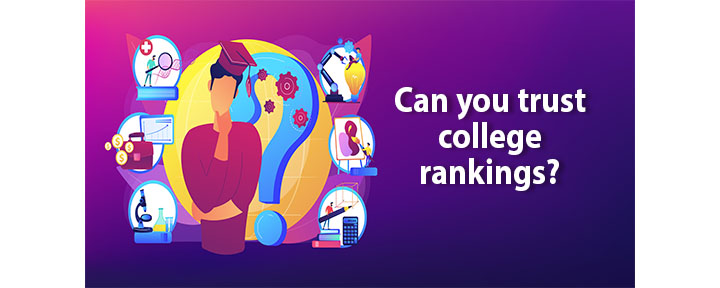
Ever wonder how the US News and World Report select which university is the best in the nation? You would hope that the researchers would create algorhythms to consider a wide range of factors to fairly determine this elite ranking. But no. Critics in the past two decades have exposed just how ratings can be easily manipulated by the colleges themselves. In order to boost their rankings, colleges simply increase the volume of students who apply. To do this, many colleges target applicants who are unqualified students and entice them with free application fees.
Stanford University, Reed College, and others have openly criticized ranking colleges based on the fact that it is impossible to objectively determine subjective characteristics such as “reputation,” which comprises 25% of the ranking. Another factor includes emphasizing research expenditures (grants and contracts) to determine the scientific accomplishment rather than considering the importance and impact of scientific discoveries.
Today, US News and World Report sells “badges” to colleges for thousands of dollars so they can post their shiny badges on their website,citing their ranking. US News started selling badges in 2010, and they now havemore than 130 categories for undergraduate and graduate programs. Do the math:4400 colleges times $20,000 (badge costs are from $8000 to upwards of $32,000 per year) equals hypothetically 88 million dollars per year.
Many colleges are opting out of playing the ranking game,especially many in the top 200. For those colleges, they already have the reputation and they use other marketing strategies to keep them in the news.But for smaller colleges, they struggle to get the incoming student yields theyneed so many colleges are compelled to pay outlandish digital marketing license fees.
With over 4400 colleges and universities in the United States, selecting the best-fit college for undergraduates and graduates can be daunting. While we all know about 200 of the well-known colleges that seemingly everyone aspires to each year – Stanford, Harvard, Yale, Princeton – making this decision can be stressful to every college-bound student.
With the high cost of a college education, parents are pushing their children to major in fields that will give them the best opportunity to secure high-paying jobs in a lucrative market. Where they get their training (undergraduate degree) often plays an important role in getting into grad schools or setting course for a successful career. STEM (science,technology, engineering, and mathematics) fields are highly sought after, andas a result, are the most competitive to get into at the top universities.
A quick Google search for the best colleges in specific fields will send students and parents to college-ranking programs like the US News and World Report. By searching for “Best Colleges” you can select from among several lists such as National Universities, Liberal Arts Universities, Engineering, Top Public Schools, Regional Colleges, and more. But don’t let the allure of the rankings mislead you.
Rather than choosing colleges based on their rankings, choose colleges based on the academic departments you are interested in studying. Check the specific major(s) at each of the colleges at the top onyour list. Then drill down to see the lower-division and upper-division requirements, and the options for electives. Check out their research,internship, capstone (senior project), and other opportunities. Then look atthe general education requirements. Consider other majors that you may want toexplore and possibly audit classes to expand your knowledge. By taking these easy steps, you’ll create a list of excellent colleges that will give you the skills and foundation you need.
While making one of the most important decisions in yourlife, research and compare colleges based on which colleges offer you the bestselection of courses and options. Visit the colleges and take tours, or scour their websites and take virtual tours. If you succumb to the rankings, just take them with a grain of salt.
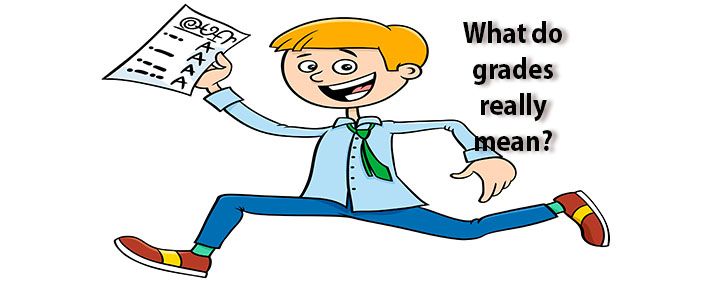
Many parents mistakenly believe their children are functioning at or above grade level for several reasons:
Grades Reflect More Than Just Academic Performance:
Class grades are not solely based on academic abilities. They often include factors like attendance, class participation, homework completion, behavior, quizzes, and tests. This means that a student can earn good grades even if they haven’t mastered the actual material.
Grade Improvement Opportunities:
Many teachers provide opportunities for students to improve their grades through late homework submissions, extra credit assignments, retaking quizzes or tests, and doing test corrections. This practice can inflate a student’s final grade, making it seem like they are performing better academically than they actually are.
Parents Trust the School System:
Parents often trust the education system and may assume that if their child is earning good grades, they are on track to succeed in college and the workforce. However, the grading system can be influenced by various factors, leading to inflated perceptions of a student’s performance.
Lack of Understanding of Educational Standards:
Some parents may not fully understand the educational standards and expectations at each grade level. They might not be aware of the gap between their child’s reported grades and actual proficiency in subjects like math and reading.
Grade Inflation:
Grade inflation is a phenomenon where grades are higher than they were in the past, and this can contribute to the misconception that students are performing at or above grade level when they may not be.
Standardized Test Concerns:
Standardized tests are not always seen as reliable measures of student potential. Some parents and educators may be skeptical of their validity and may rely more on class grades.
To address this issue, it is important for parents to have open and regular communication with their child’s teachers. Discussing a child’s academic progress and areas where improvement is needed can provide a more accurate picture of their performance. Additionally, parents can take an active role in their child’s education by providing supplementary resources and activities that help them develop critical thinking, problem-solving, and analytical skills beyond what is covered in the classroom. This approach can help ensure that a child is truly prepared for success in college and their future careers.
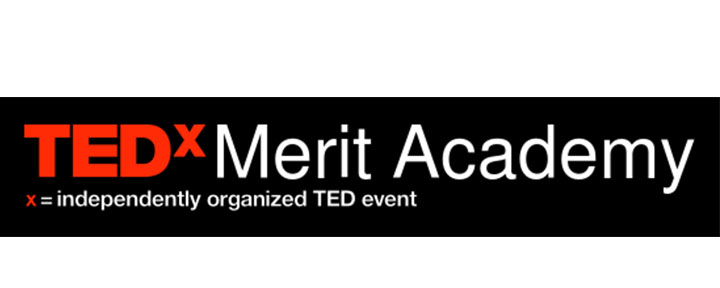
We have an exciting lineup of speakers this year! Join us to learn about ideas worth spreading.
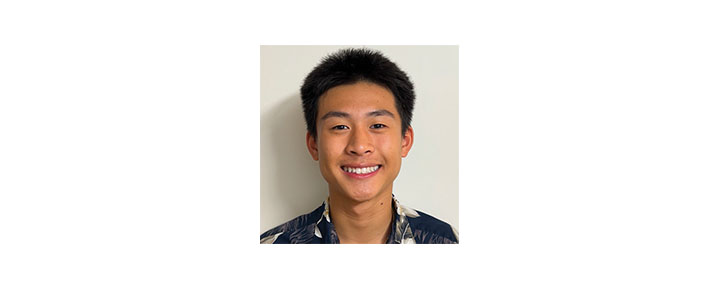 A Drug-Free Alternative Treatment for IBD by Nicholas Tran
A Drug-Free Alternative Treatment for IBD by Nicholas Tran
Today, Inflammatory Bowel Disease (IBD) is rapidly spreading with the Westernization of our diets, causing an influx of unhealthy processed foods which cause catastrophic and irreversible damage to our gut. IBD is lifelong and unpredictable in nature, casting a heavy toll on a patient’s mental health, especially those diagnosed with early onset IBD. Nicholas discusses the gaps within IBD treatment and offers his own solution, an app focused on improving patient quality of life through positive nutrition.
At 14, Nicholas was diagnosed with Crohn’s disease. He fundraises to find a cure and organizes events to bring his community together. Nicholas also enjoys playing golf with his dad, and with his free time, he explores ingredients and creates new and friendly recipes that spice up the culinary delights of IBD patients.

Spice, Medicine, or Both?: Turmeric & Health by Neha Surendar
Ayurveda, a 5,000 year old holistic healing system, focuses on balancing bodily systems to maintain health. A critical ingredient in Indian cooking and medicine, turmeric has a long tradition as a versatile spice. As Western healthcare becomes more focused on pharmaceuticals, Neha Surendar believes turmeric and its antioxidative properties should be part of the conversation about treating a variety of conditions. Her talk challenges the audience to consider how turmeric can impact their health.
Neha Surendar is a high school senior who lives in Texas. She competes in Speech & Debate, ranking among the top 25 students in Texas. Neha embraces her Desi culture and recently took an interest in learning about its culinary traditions. Upon graduation, Neha intends to study neuroscience and pursue a career in healthcare.

Using Technology to Address Homelessness by Aidan Levan
In 2022, San Jose spent $116 million on homelessness. As the homeless population rises, action must be taken. Aidan Levan created an app called Loved Ones Are Found to help connect the homeless with their loved ones. Through crowdsourcing, this app can locate the homeless and reconnect them with their families while also getting them off the streets. Whether families are looking for their lost homeless loved one or a homeless person is looking for their family, people can reunite through the app.
Aidan Levan is the creator of the app, Loved Ones Are Found. He is fascinated by mechanical engineering, guitars, and cars. He plays lead guitar in his band, and he enjoys to play rock music. Aidan just came back from South Africa and Vietnam. He loves to travel with his family and play with his two poodles. He hopes to become a mechanical engineer and design cars.

Track a Gun: A Crowdsourcing Solution to Active-Shooter Violence by Kiran Sunil
Over the past 9 months, there have been over 25,000 deaths by gun violence. Kiran created Track A Gun, an app that empowers communities to prevent gun violence. Through crowdsourcing, this app can help people share what they see and hear in real time so victims can decide to run for shelter, hide from the shooter, or protect loved ones during an active-shooter incident. Join Kiran to learn how innovation and the power of collective action can foster safer, more connected communities.
Kiran Sunil is a high school senior from San Jose. He enjoys playing tennis and basketball, as well as participating in programming and robotics competitions. He aspires to continue studying computer science, and pursue a career in software development. He is determined to leverage technology to reduce gun violence.

How Vaping is Affecting More Than Just Your Lungs by Mehtaab Dhillon
Vaping is this generation’s new medium to consume nicotine and weed, and like cigarettes, users are getting more than just nicotine and weed. A concerning portion of the youth is falling victim to the propaganda of Big Tobacco who has framed vaping as a healthy alternative to smoking cigarettes. New research shows that this is the case. With the recent global pandemic, it is important to understand vaping’s effects of vaping on our immune system and with the help of controlled research, expose Big Tobacco’s lies.
Mehtaab Dhillon is a high school senior from the Central Valley. He aspires to become a physician and master communication to become the most effective physician possible. Along with effective communication, Mehtaab wishes to create a healthier society fueled by his passion for Biology and Chemistry. For fun, Mehtaab enjoys distance running and spending time with family.

Trauma on the brain by Daisy Payton
The neurobiological effects of PTSD can vary based on personal touch. PTSD is caused by extreme trauma and is seen most in women and people of color. Research shows that long term experience of traumatic stress has drastic impacts on specific structures of the brain, like the prefrontal cortex. These disruptions can affect the ability to regulate emotion, learn, and form new memories and it looks different in every gender, demographic and stage of development. It is treatable.
Daisy attended the University of San Francisco and received her degree in Psychology and minor in Neuroscience. Currently, she runs her family’s ranch and cares for her hoard of animals. She’s applying to Psychology and Behavioral Neuroscience PhD programs this fall and plans to research genetics, neural basis of emotion, and psychopathology. read more
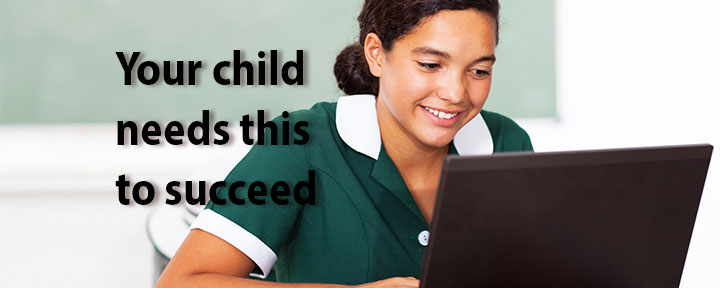
Now that students are back in school, let’s set them up to build strong study skills. I’m teaching these skills to students of all ages – even my high school seniors – to improve their grades and to reduce their stress.
To start, they’ll need to get organized so they don’t stress out when facing their long lists of things to do. By using Google Calendar (GCal), they’ll see how and when each homework, paper, or test prep will be done. I like GCal because it’s easy to use and it’s right on their cell phones so they have it with them all the time.
Here are the 8 steps to building strong study skills using GCal:
1. Set up GCal
Enter each class in GCal for the entire week, and make it repeat (recurring feature) for the school year. Some schools have the same class schedules Monday through Friday. Others have block days with longer classes. Refer to your school’s bell schedule to get the approximate times for each class. Then look at the school’s minimum days, teacher in-service days, and school holidays. Make sure that their GCals are accurate for the entire school year.
2. Enter Due Dates
Looking at each class’s syllabus or online homework reminders, enter homework, test dates, and other deadlines on the dates that they are due (not the days they are assigned). This will help your child prioritize what should be done first, and allow enough time to complete all necessary steps. If teachers don’t give students official due dates ahead of time, your child will need to adjust the study plan daily.
3. Add Extracurricular Activities
Next enter in all extracurricular activities and include time for transportation. They might block off 2 hours for practice plus 15 minutes of driving to and from the game. Remind them about sports, music lessons, doctors’ appointments, and social activities. Consider dinner time; do you have a set time for dinner each night? Block off time for all after-school activities including showering after games.
4. Plan When to do Homework
Now that you know when homework is due, your child could block off time to do each facet of the assignment. If they have to complete all math problems on page 8, have them block off one hour to complete it at a time that works for them. They could plan homework around commitments so they could see how they might juggle homework and baseball practice.
5. Steps for Test Preparation (not cramming)
Test preparation will take a little more planning than homework. First, make a list of each step needed to prepare for the test. They may need to read a chapter, review lecture notes, make a study guide or flash cards, meet with a study group, and research other sources (Khan Academy, Google searches). By blocking off time to do each of these tasks over a week in GCal, they’ll learn the concepts at a deeper level than cramming the night before a test. This also gives them time to ask the teacher for help if they don’t understand something before the test.
6. Organize Writing Papers
Writing a book report or research paper will take even more planning than for tests. They’ll need to select the topic, research the subject, write a thesis statement, make an outline, write a rough draft, edit the paper, add a bibliography, include other required materials, and submit it. Some of these steps may take several hours over several days. Like preparing for a test, make a list of all of the steps they’ll need to take to complete the assignment a few days before it is due, and then block off time for each task in their GCal. This will reduce the stress and give them plenty of time to write their report or paper.
7. Reschedule for a Healthy Balance
Review the GCal to see how much time is dedicated to school and after-school activities. Some students create different calendars (school, extracurricular activities, friends, college prep) with different colors so they can quickly see how balanced their lives are. If there isn’t enough time to relax and have fun with friends, then your child could move tasks to another day to ensure that there is a healthy balance of academics, exercise, and social activities. Just check deadlines and test dates and prioritize accordingly.
8. Prepare for Finals Now
Once a week, have your child review everything covered in classes to date. They can glance over previous quizzes and tests, flashcards, and lecture notes over the weekend. Simply block off time to study “Alls” each week. This will help build a deeper conceptual understanding of the material and improve long-term memory. That way, when they need to prepare for midterm or final exams later in the year, they won’t have to cram because they’ll already be prepared.
9. Highlight the Activity When it’s Done
After your child goes to class, does the task, or participates in an activity, they could highlight with their favorite color. That way, they’ll see what they’ve accomplished throughout the day. Success begets success. If they didn’t go to class or do an assignment, they just need to move it to another time or day so they can still meet the deadline. If they know it’s going to be late, they could email the teacher to let them know ahead of time. This teaches responsibility and good etiquette. read more
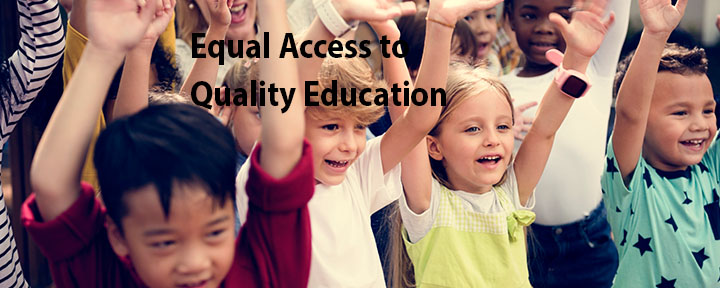
In my previous article, “Ramifications of Affirmative Action Ban on College Admissions,” I addressed how affirmative action really affects college admissions by creating substandard classes and dumbing down our best universities. Instead of giving free passes to students who meet ethnic and socioeconomic numbers, let’s level the playing field so all students have similar opportunities to compete for admission based on merit. We need to start teaching academic skills in preschool and offer cutting-edge courses in K-12. Remember there are over 4,000 colleges in the United States, and most will accept all applicants. For the sake of this article, we are only addressing the super selective colleges with acceptance rates below 10%.
Academic preschool for all
We need to offer FREE academic preschool programs for all children. The poor, inner-city students should have the opportunity to learn reading readiness skills at 3 years old and be reading chapter books by the time they enter kindergarten — just like the wealthy students. Teachers should be paid more to teach in inner city schools and be paid bonuses when their students reach or surpass grade-level standards and/or win science fairs.
Set up your own preschool
Parents can set up free preschool enrichment programs for their children in their homes. This will give their children a solid academic foundation before entering kindergarten. I successfully did this for 9 years and my daughters went to Stanford University and Claremont McKenna College. By inviting 3-4 tuition-paying students to cover the costs, hosting families receive free preschool for their children. That means that all children can experience the crème-de-la-crème preschool that only rich kids receive today. This model also works for elementary, middle, and high school students. Parents can set up after-school support to build critical reading, essay writing, and math skills. Hosting families receive these services for free. Check out my book and the curriculum.
Improve K-12 education
Enhance the quality of education in primary and secondary schools is crucial to prepare students for college. Providing modern resources, qualified teachers, and an academic and STEM curriculum can help bridge the educational gap between the haves and the have-nots. Teachers should be paid double what they make today. We have a massive teacher shortage across the United States – college students don’t aspire to become teachers because they don’t want to live in poverty.
Encourage students to do projects
Schools can set up mentorship programs with retired professionals to guide students as they brainstorm, initiate, and complete projects. This exposure can introduce students to lucrative careers and fascinating college majors. Projects give all students the opportunity to build their portfolios and increase their odds of admission to top colleges.
Expand pre-college programs
Implement pre-college programs, such as academic enrichment programs, mentorship initiatives, and college preparatory courses, can help disadvantaged students gain the necessary skills and knowledge to succeed in college. These programs can offer guidance on the college application process, standardized testing, and financial aid options.
Increase financial aid
Access to financial aid is a significant barrier for many students seeking higher education. Increasing the availability of need-based scholarships, grants, and loans can alleviate the financial burden and make college more affordable for students.
Target support for underrepresented groups
Address historical inequalities. Specific support programs can be developed for underrepresented groups, including Black, Hispanic, Native American, and first-generation college students. These programs can offer mentorship, academic support, and resources tailored to their unique needs and challenges.
Strengthen community college pathways
Community colleges can bridge the gap between high schools and a 4-year colleges. Enhancing transfer pathways to provide academic support and ensure seamless credit transfers can facilitate a smoother transition to bachelor’s degree programs.
Expand student bodies at selective colleges
If these high-demand colleges opened up 50% more spaces each year, it would take off some of the pressure to select under-represented ethnic students who may not meet admission standards. More spaces could allow for a more diverse student body. With the massive endowments these selective colleges have, building more dorms and classrooms wouldn’t put a dent in their budgets. Besides, more students means more tuition.
These are 9 ways to level the playing field for admission to the top universities so that all children receive the academic and social exposure needed to prepare them for higher education. Students should be able to take advantage of early reading and math preschool programs so they can excel in K-12. By having access to excellent teachers (regardless of your zip code) and programs to prepare them for the rigorous college admissions process, qualified students will not be a concentrated group of upper class and White/Asians. In an ideal world, during senior year of high school, colleges should admit students based on their academic prowess, innovation, and what unique characteristics they will add to the incoming freshman college class – not their ethnicities. read more
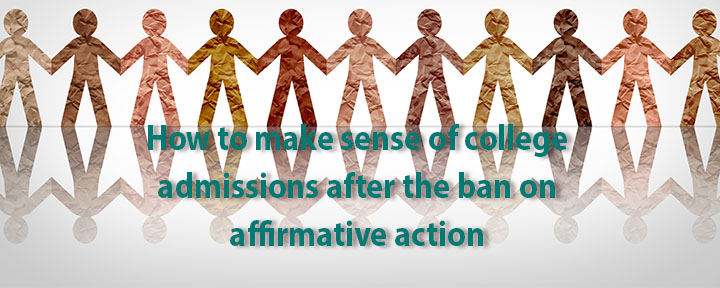
Who benefits from Affirmative Action?
Affirmative action policies were designed to address historical and ongoing inequalities by providing preferential opportunities to Black and Hispanic students that have been marginalized or disadvantaged. These policies were aimed to promote diversity, inclusion, and equal representation in education.
Who is targeted by Affirmative Action?
Critics of affirmative action argue that it is unfair to Asians and Whites who may be denied admission to as a result of these policies. They believe that affirmative action can result in reverse discrimination by favoring individuals based on their race or gender, rather than their individual merit. It undermines the principles of fairness and equality; students should be evaluated solely on their qualifications, skills, and abilities, rather than their demographic characteristics.
What about minimum admission requirements?
Most selective colleges claim that all students meet their admissions standards. However, I work with students who have been admitted to elite colleges through affirmative action and they often come to me because they’re struggling to pass their classes. When students don’t have the critical reading or essay writing skills needed to succeed at these top universities, they often feel like imposters or failures, and these negative experiences can haunt them for the rest of their lives.
What about legacies?
According to Insider Higher Ed, University of Southern California (USC), Pepperdine University, and Vanguard University admitted some legacy students who did not meet the minimum admissions requirements. USC admitted eight students over the past 4 years who were related to donors or alumni but didn’t meet admission requirements. Two of these students hadn’t even taken Algebra 2 in high school and two others hadn’t graduated from high school. Over the past 3 years, Pepperdine admitted ten legacy students and Vanguard admitted nine students who didn’t meet the university’s standards.
When colleges select their incoming students based on family legacies and large financial contributions, they dumb down their incoming classes. When parents donate large sums of money to get their children into selective colleges, they send heartbreaking messages to their children that they don’t believe their children can get into college. Some parents involved in the Varsity Blues Scandal went to prison when they were caught bribing admissions officers, paying off SAT proctors, and buying coaches to lie about their children’s athletic talents. Why would a parent want their child to be the bottom of the class and struggle to graduate because they don’t belong there?
Should top universities admit the best students?
There are over 4,000 colleges and universities in the United States, and only a few are highly selective (acceptance rate lower than 10%). That means that most colleges will admit just about anyone who applies. But those elite colleges, should be allowed to enroll the smartest students to work with world-class professors so these institutions can create innovative and inspirational think tanks. Imagine the synergy in discussion groups and the solutions to major problems that these brilliant students and professors could solve. Here in the United States, we have produced more patents and started more innovative businesses than any other country in the world, but we may be losing our winning edge to China and Japan.
We shouldn’t lower the productivity of these institutions by focusing on ethnicity-based quotas, which reduce the space to enroll the best students. Seeking a diverse student body from various socio-economic and ethnic backgrounds makes this mix of students even more dynamic, but should only be considered for tie breakers when two students have equal talent and brilliance.
The key is finding a way to select students for these exceptional higher education institutions without having to fulfill quotas and lower academic standards. I’ve addressed productive and realistic ways to make top colleges accessible to a diverse group of students in another article. Let’s keep this discussion going!
Smartphones are facing scrutiny in classrooms from K-12 to college. Some teachers prohibit cell phones inside the classroom because their alerts, text messages, and social media updates are a distraction to the students. Other teachers allow them because students need easy access to information, assignments and calendars. Are smartphones interfering with academic productivity and learning?
While students are clicking on messages and checking out images of their friends, these interactions on their smartphones often trigger anxiety, and FoMo (fear of missing out) when they see that their friends are engaged in exciting activities while they’re stuck in a classroom or their bedrooms. Although the students may physically be in the classroom or at their desks doing homework, they are not engaged. That’s why it takes an inordinate amount of time for students to get their assignments done each day.
Having instantaneous contact with virtually all friends also creates a heightened and possibly overwhelming influx of information. This doesn’t give students the downtime they need to contemplate much of what they’re trying to process because they are receiving constant information. When it comes time to prepare for midterms or final exams, many students complain that they don’t remember concepts that they learned earlier in the year. This makes it difficult for them develop collective knowledge (long-term memory) over time – a vital part of the learning process.
Similarly, students really can’t multitask. Many think they can listen to a lecture while answering questions on a worksheet. If they attempt to do both activities at the same time, chances are both will be done poorly because they can only focus on one subject at a time. In other words, they need to focus on one task until they complete it, and then move on to the next task. Only then can they put in the concentration needed to get the task done well.
A recent study explored the psychological impacts of smartphones in college classrooms. Melissa Huey, assistant professor of behavioral sciences at the New York Institute of Technology, examined students’ mindfulness, anxiety, and course comprehension with students who relinquished their smartphones during classes vs. students who had access to their phones throughout class lectures.
The students who were engage in classroom lectures free of smartphones had significantly lower anxiety levels and higher comprehension and mindfulness than those who had unlimited access to their smartphones during classes. The students conducted self-reported scores to reach these conclusions. This study was conducted over a six-week period in two classes.
Huey contends that the nation’s polarization and the role of social media in spreading misinformation are tied to our students’ difficulty in managing conflict resolution skills. Both in and out of the classroom, she examined the importance of critical thinking and how smartphones interfere with the ability of students to deal with daily stressors.
Students, and even parents, may need to give themselves a time out so they can stop the ever speeding treadmill on which they are racing – just to keep their heads above water. Maybe we all need to put away our smartphones while we go to class or work, and spend electronics-free time with our family and friends. Connecting with one another and engaging in conversations and activities without our smartphones may give us the opportunity to laugh, have fun, and learn something. Maybe we need to establish simple rules in the classroom and at home to give our children, and ourselves, a healthier atmosphere, and in turn, positive academic productivity and learning.
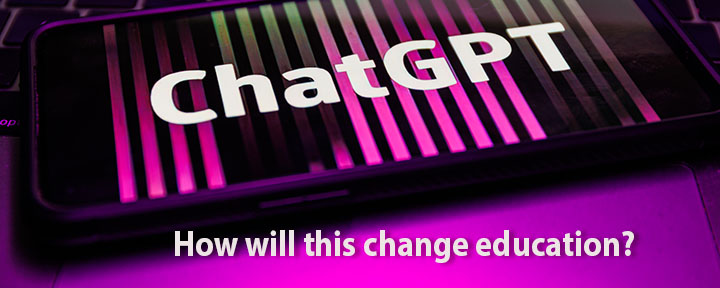
When spell check and grammar check features became available in the late 1970s, critics feared that we would rely on technology to edit our work and that the quality of our writing would diminish. Then when the internet first appeared in 1983, critics worried that people would lose the ability to think critically.
Both the internet and spell/grammar check features have become a mainstay in writing and we rely on them for research and editing our work. Today ChatGPT – an artificial intelligence software program that provides instant research results and can write an original essay in a matter of seconds – is the new obsession. Teachers and administrators are anxiously searching for ways to ban it and penalize students for using it.
Now that the genie is out of the bottle, there’s no putting it back, so we best find how we can make GPT a positive educational tool.
One of the benefits of GPT is that all students have equal access to it. It’s like having a private tutor, 24/7, to answer questions and help write essays. Up until now, only wealthy students have had access to private tutors who teach concepts that they didn’t get in school and help them prepare for exams. These students have also had the luxury of private tutors who organize, edit, and even write their essays. With GPT, all students will have the opportunity to get individualized attention and guidance. It actually evens the playing field between the haves and the have nots.
I recently opened a GPT account to experiment with it. I recommend that everyone do this before condemning it. Go to https://chat.openai.com/chat to enter a question. Ask it to write an essay. You’ll see that it writes a good essay using proper grammar and spelling. It may suggest that you add information to personalize it. As you read the responses, you’ll see that GPT functions like a personal search engine and secretary. The writing style is basic; nobody is going to win essay contests with GPT.
While we have become dependent on spell check, has created a generation of poor spellers. Likewise, grammar check helps us keep pronouns matching their antecedents, and reminds us of parallel structure and verb agreements, but sadly, has not helped us learn these skills as they autocorrect our writing. In other words, spell check and grammar check features temporarily help students with assignments but they don’t make them better writers.
Recently, teachers now have access to software that will be able to detect if ChatGPT (or other programs) were used in writing students’ essays. This will be a never-ending challenge for the AI and the software-detection developers, similar to the programs that teachers use to detect plagiarism.
Some teachers are now requiring students to handwrite in-class essays. Others are providing students with word processors that allow them to type their responses in class without access to the internet. GPT is forcing us to quickly adapt to new ways of doing research and writing essays.
When classes were conducted online in Zoom during the COVID pandemic, teachers cleverly administered exams (without access to search engines and textbooks) while students were at home. Naturally, some students found ways to cheat by finding ways around GPT-detection software.
Since OpenAI released GPT-3 in June 2020, there’s been an uproar about how to grade student performance. Maybe we’re going to have to rethink what we are testing and how we are evaluating student learning. With search engines at our fingertips 24/7, do we really need to make students memorize facts like dates and names? If we want students to identify their beliefs or perspectives, should we allow them to use GPTs to write the first draft but require them to personalize their ideas by incorporating them in further drafts? Maybe teachers will ask students to defend their writing or request that they add new material that will require critical thinking, research, grammar, and style to their essays.
If GPT helps everyone produce well-written essays and comments that reflect their ideas, should we welcome this refreshing opportunity? Over the past decade, the ability to communicate ideas in writing have dwindled away with the vast expansion of text messaging. Without an emoji, many text messages are incoherent and often don’t make sense. Has good writing become a lost art?
The future of GPT programs and software to detect machine-generated text will be ever improving. I hope that students will learn how to use these powerful resources to improve their written communication skills by giving them a start with GPT drafts. Educators have a new opportunity to teach concepts, utilize these AI software programs, and evaluate student learning and progress. We are in the midst of a huge paradigm shift – whether or not we like it.

Kids these days! We’ve left them holding the bag of unintended consequences of our own indulgences, yet our children are still vested in righting our wrongs. What solutions might they find if given the opportunity and resources?
Ishan and Alisha Bhatia are twins. People ask: Do you think alike? You could say so. Both tackled the same global crisis: water pollution, each from a unique perspective. Before they were out of high school, each had discovered viable solutions and showcased them in talks at TEDxMeritAcademy.
Here’s what they have to say:
Ishan
Imagine a contagion that popped out of nowhere, threatening 385 million lives with cancer, birth defects, and DNA degradation. It travels through the air, through our food, and even worse — through water. Seemingly innocuous streams meander along, spreading this contagion everywhere.
Unfortunately, this is our reality. Every year, 5.6 billion pounds of pesticides are used worldwide, contaminating our water and food supplies.
After years of research, I discovered an alternative to deadly commercial pesticides that’s just as powerful yet completely safe: Cordyceps militaris.
This is a mushroom specialized to kill insects, using spores that breach their exoskeletons, disarm their immune systems, and extract nutrients until the critters die. Only 8% survive the mushroom, versus 5-10% against conventional pesticides.
But to you and me, Cordyceps militaris is a friend, used for thousands of years as a health supplement. That’s as safe as it comes for a pesticide.
At TEDxMeritAcademy, I encouraged gardeners to use Cordyceps militaris to rid their plants of common pests like aphids. You can do the same, just by visiting my website, cordyceps-pesticide.com, for instructions for making your own Cordyceps militaris spray.
Try it! Let me know which insects and plants it works with. Let’s identify all the insects that Cordyceps militaris can attack, and start replacing toxic pesticides today.
There’s a role for each of us in making our food and water safe. Will you join me?
TEDx Talk: bit.ly/3CXXFyW
Alisha
Flames spew from a garden hose and smoke permeates the sky. Laughter-filled playgrounds become toxic cemeteries of childhood memories. In 2015, there were 300,000 hydraulic fracturing wells in the US. Today, there are over 1.7 million.
Noxious fracking fluid infiltrates our aquifers. Communities unknowingly ingest water with over a thousand of volatile organic compounds, heavy metals, and bacteria. The result: cancer, neurological disorders, organ failures, and high-risk pregnancies.
Starting in middle school, I channeled my hope into devising an affordable water filter specialized to capture fracking toxins. I developed a prototype using a pump sprayer, activated carbon, an ethylenediaminetetraacetic acid resin, and a 0.2 micron filter. My filter significantly removed total organic carbon, copper, and microorganisms, though I plan to continue fine-tuning the design.
I was just getting started.
Energy companies were still recklessly drilling. The cries of people petitioning for clean drinking water were lost in a sea of corporate control. Poisoned families were targeted with public ridicule and relocated from their homes under gag orders, preventing them from exposing the deadly truth about fracking.
My years of research culminated in my TEDxMeritAcademy talk, We Have a Big Fracking Problem!. I exposed the companies responsible, sounded the alarm over fracking-induced fatalities, and detailed my water filter solutions.
Wanting to do more, I developed America Is Fracked Up, a national organization. Through its website, www.americaisfrackedup.com, people can locate fracking wells, learn more about commercial water filters, and sign a petition to make gas companies provide them. Instead of spending millions to fight the truth, companies must channel their resources to repair the damage they’ve done and provide Americans with clean drinking water.
Will you join me?
TEDx Talk: bit.ly/3HeRSHD
We count on our young people to see the world with fresh eyes. Four million teens in this country start high school every year, each of them brimming with potential. Imagine if all students had the opportunity Ishan and Alisha did to start projects and discover practical solutions to the challenges we face. How much more would these students learn? How much more self-assured would they be, knowing what they’re capable of? And how much better off would we all be, as beneficiaries of their powerful contributions?
